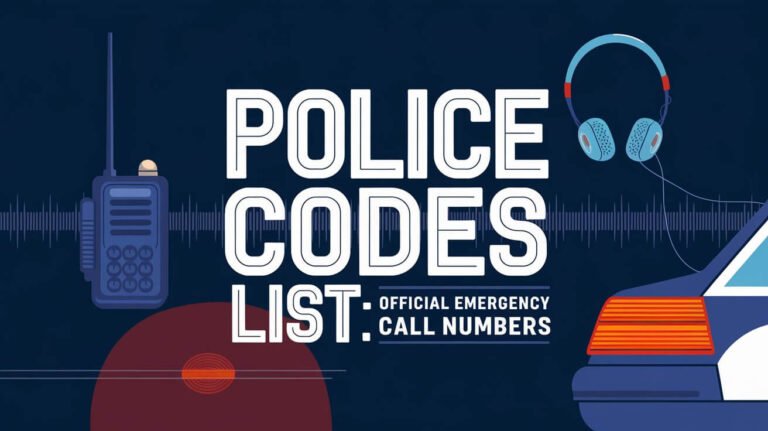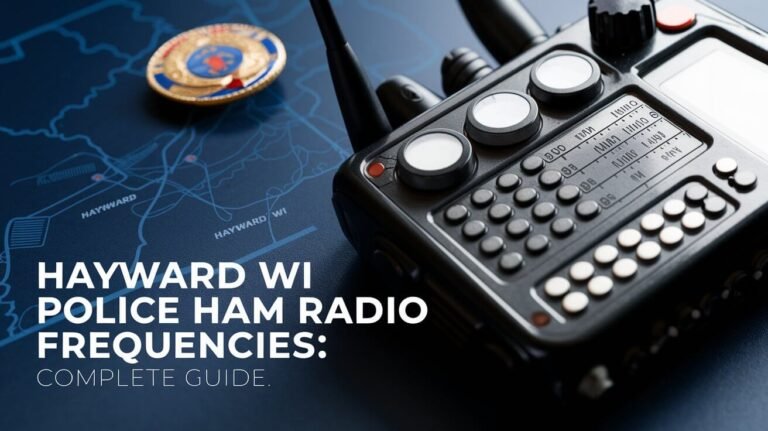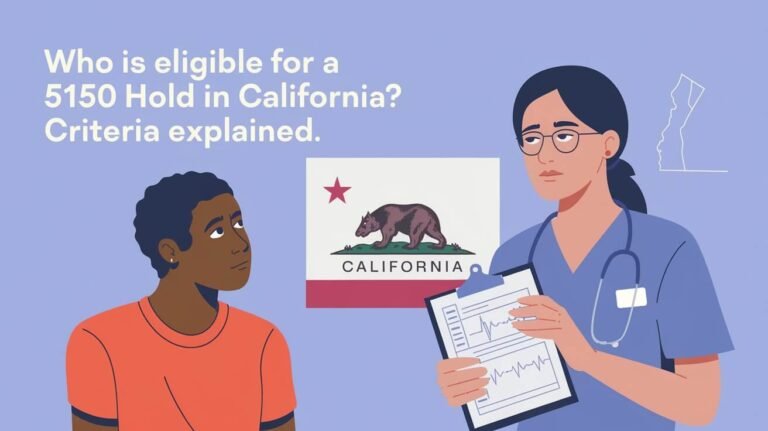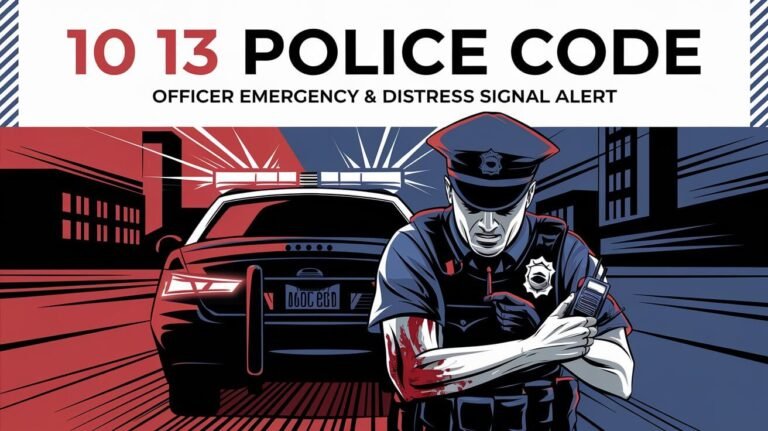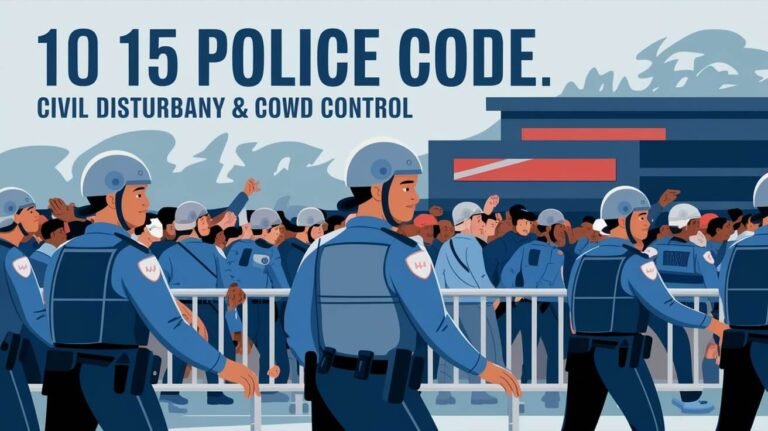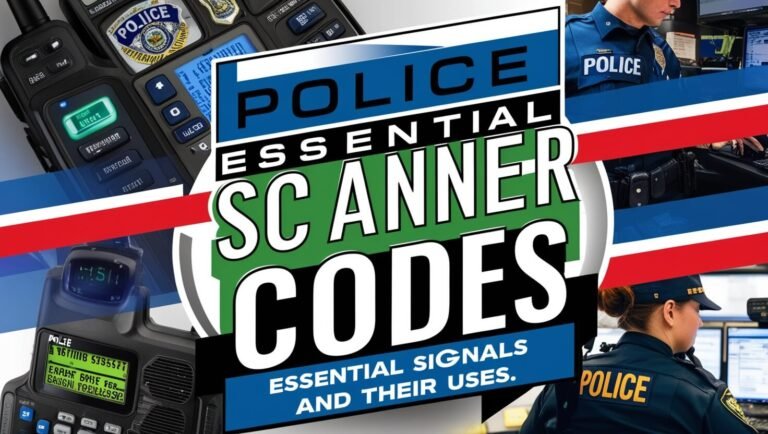10 22 Police Code: Emergency Vehicle Standby Status Signal
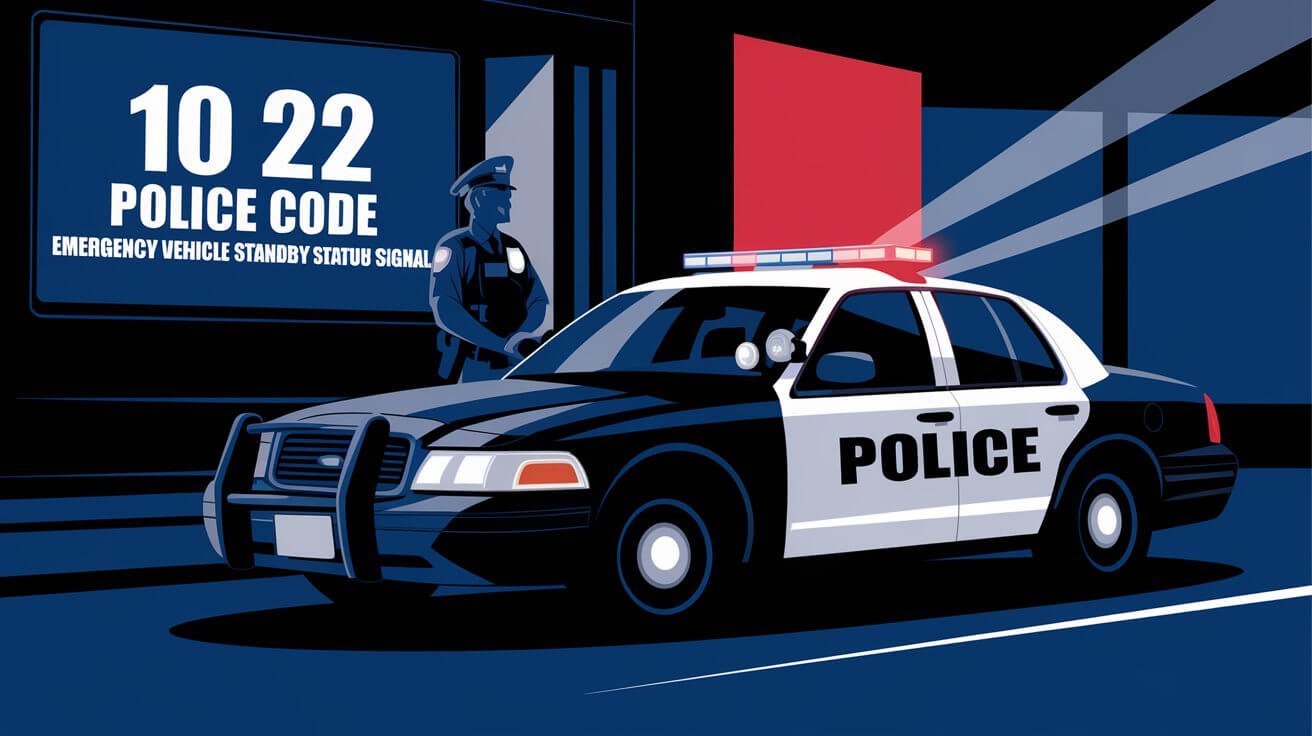
The 10-22 police code is key in law enforcement communication. It’s part of a system of radio signals and dispatch codes used by police in the U.S. This code tells officers to disregard a previous order, often during a break-in or when canceling a task.
Knowing these police codes is vital for clear communication among officers. They help in status updates and emergency responses. This ensures coordination and effective decision-making in critical situations. We’ll explore more about these codes and their use in police work.
Radio Communication Fundamentals in Law Enforcement
Effective radio communication is key for law enforcement. Agencies use standardized codes and protocols for clear, efficient talks. Knowing how to use the radio, follow channel rules, and keep signals clear is vital for officer needs assistance and emergency response protocols.
Basic Radio Operation Standards
Radio etiquette and clear speech are critical. Officers learn to speak briefly and avoid slang. This helps keep channels clear for everyone.
They also know to keep personal talks off shared channels. This ensures communication stays professional and effective.
Communication Channel Protocols
Law enforcement has specific channels for different needs, like dispatch or tactical ops. Officers must follow these rules to communicate well. This includes knowing when to use each channel and the right call signs.
Signal Clarity and Reception Guidelines
Good signal quality is essential for clear communication. Officers check signal strength and report any problems to dispatch. If needed, they move to get a better signal.
| Key Radio Communication Protocols | Description |
|---|---|
| Proper Radio Etiquette | Using clear, concise language and maintaining professional conduct on shared radio channels. |
| Channel Designations | Understanding the purpose and appropriate use of each radio channel, such as dispatch, tactical, or inter-agency communication. |
| Signal Monitoring | Reporting signal strength issues and relocating to improve reception when necessary. |
10 22 Police Code: Definition and Primary Usage
The 10-22 police code is very important in law enforcement. It tells officers to ignore the last task they were given. This happens when a situation is solved or when new info makes the old task not needed.
This code helps avoid confusion and makes sure police resources are used well. It lets officers know they can stop what they’re doing and focus on something else. This way, police work more efficiently and don’t waste time.
The 10-22 code works with other police messages, like “10-4,” which means a message was understood. Using these codes helps police work better together. This makes them more effective in serving their communities.
Essential Police Radio Codes for Daily Operations
In law enforcement, clear communication is essential. Police radio codes help send important information quickly and clearly. These codes, based on the APCO system from 1937, are a common language for officers and dispatchers.
Status and Location Codes
Status codes, like “10-4” for yes and “10-20” for location, help officers share their status and location in real-time. These codes make coordination and emergency response smoother. Vehicle codes, such as “10-27” for driver’s license checks, also make traffic stops and investigations easier.
Emergency Response Codes
In urgent situations, emergency response codes are used. For example, “10-33” signals a need for immediate help in life-threatening cases. Codes like “10-32” for a gun presence and “10-45” for a bomb threat help officers quickly identify and respond to critical incidents.
Vehicle-Related Communication Codes
Clear communication is vital during traffic incidents for officer safety and efficient management. Codes like “10-50” for accidents and “10-54” for hit-and-runs help coordinate responses. “10-52” for an ambulance request ensures medical help is sent quickly.
| Code | Meaning |
|---|---|
| 10-4 | Affirmative |
| 10-20 | Location |
| 10-27 | Driver’s license check |
| 10-28 | Vehicle registration request |
| 10-33 | Emergency |
| 10-32 | Gun presence |
| 10-45 | Bomb threat |
| 10-50 | Accident |
| 10-54 | Hit-and-run |
| 10-52 | Ambulance request |
These police dispatch codes and radio call signals are key to effective communication in law enforcement. They help officers respond quickly and correctly to various situations they face daily.
Emergency Response Signal Classifications
In law enforcement, emergency signals show how urgent a situation is. “Code 3” means lights and sirens are needed for a quick response. Some places use special codes for different emergencies.
“Code 30” means an officer needs help right away. “Code 33” signals a mobile emergency needing clear radio communication. These codes help get quick help to those who need it most.
The Police 10 Codes are a set of signals for emergencies. They cover things like disturbances, crimes, accidents, and help requests. Each code tells responders what’s happening and how fast they need to get there.
- 10-46: Motorist assist
- 10-52: Ambulance needed
- 10-70: Fire alarm / Prowler
- 10-74: Negative / Theft
- 10-79: Notify coroner / Bomb threat
- 10-80: Pursuit in progress
- 10-99: Cardiac arrest / Officer held hostage
- 10-106: Obscenity
- 10-107: Suspicious person
- 10-109: Suicide
These protocols make sure urgent situations get the right help fast. They help officers and responders work together to tackle the most critical issues.
Regional Variations in Police Communication Codes
Police communication codes vary across the United States. This is due to local laws, operational needs, and departmental preferences. You can see these differences when comparing the East and West Coasts, as well as state-specific protocols.
East Coast vs. West Coast Differences
East Coast law enforcement uses different 10 codes than the West Coast. For example, code 10-22 on the East Coast means “Disregard” or “Cancel.” On the West Coast, it means “Investigate Suspicious Circumstances.” Officers must know the codes for their area to communicate well in emergencies.
State-Specific Protocol Adaptations
- In California, police use Penal Code numbers for crimes, like Penal Code 187 for homicide and Penal Code 211 for robbery.
- The California Highway Patrol (CHP) has its own 10 codes. For example, 10-4 means “Understood, message received” and 10-15 means “Subject in custody.”
- New York uses the International Phonetic Alphabet for radio communication. Each letter has a specific word for clarity, like “A” for Adam and “Z” for Zebra.
These state-specific codes show the varied needs and laws across the United States. They stress the need for law enforcement to know the codes in their area, for better collaboration and mutual aid.
Critical Safety and Alert Codes
In law enforcement, officers often face unexpected situations. They need to act fast and get help quickly. Police departments use critical safety and alert codes for this. These codes help officers quickly tell others about the situation.
Some key codes include 10-33 (Help quick), 10-78 (Officer needs assistance), and 11-99 (Officer needs help). These codes call for help from nearby officers. They start emergency plans. Other important codes alert officers to armed suspects or when they’re being followed.
| Code | Definition |
|---|---|
| 10-33 | Help quick |
| 10-78 | Officer needs assistance |
| 11-99 | Officer needs help |
| 10-32 | Armed suspect |
| 11-55 | Officer being followed |
These codes are key to keeping officers and communities safe. They help law enforcement respond fast and work together. This way, they can handle emergencies well and support officers in trouble.
Digital Age Adaptations in Police Communications
Law enforcement communication has changed a lot with digital technology. Now, police use encrypted radios, mobile data terminals, and more. These tools make security and work better. As technology grows, police are updating their radio signals and rules to keep up.
Modern Technology Integration
Police departments in the U.S. are using digital systems to make their radio signals better. Encrypted radios keep important info safe from hackers. Mobile data terminals let officers check data and get dispatches from their cars, making things faster and easier.
Enhanced Security Measures
Police know keeping communication safe is key. They use encryption, authentication, and other methods to protect their signals. This keeps vital info safe and helps keep officers and communities safe.
As police move into the digital age, using new tech and security is vital. These steps make police work more efficient and keep important info safe. This helps law enforcement do their job better.
Common Mistakes in Radio Code Usage
Using police dispatch codes correctly is important for clear radio communication. But, mistakes in using these codes can cause confusion, slow down help, and even put people in danger. It’s important for police to work on fixing these issues to improve their talks.
One big problem is using old or different codes. As tech and rules change, some codes might not work anymore. Police need to keep up with the latest codes to talk smoothly.
Another issue is using too many codes when simple words would do. Codes are meant to be quick and clear, but using them too much can cause misunderstandings. It’s important to find a balance between using codes and talking clearly.
Also, codes can mean different things in different places. Police in different areas might use different codes. Knowing these differences is key to avoiding mistakes and understanding each other better.
To fix these problems, police focus on training. Officers need to know how to use codes right, talk clearly, and understand local differences. This way, police can work better together and serve the community better.
What You Learned
The 10-22 police code is key in law enforcement’s work. It helps officers talk clearly and quickly. This is important for them to work together and keep everyone safe.
Even though different places use different codes, the basics stay the same. New technology has made police work better. It helps them protect us even more.
Learning police codes is more than just following rules. It’s a skill that helps officers do their jobs well. Knowing the 10-22 code helps them work together better. This makes our communities safer and more trusting of the police.

